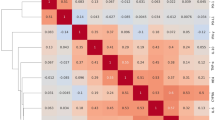Abstract
Aim-Background
Breast cancer is a problem of enormous magnitude. The response to chemotherapy is also variable in patients and the exact biochemical pathways responsible have not yet been identified. There is an urgent need to identify bio-markers that can assess response to standard chemotherapy. The aim of the study is to help in early identification of non-responders and subsequent initiation of individualized chemotherapy.
Methods
The study population comprised of 30 cases of locally advanced breast carcinoma and 30 healthy controls. IL-6 levels were measured by ELISA before the commencement of treatment. Standard Anthracycline-based chemotherapy (Cyclophophamide 500 mg/m2, Doxorubicin 50 mg/m2, 5-Fluorouracil 500 mg/m2) was given to all patients as 21 days cycle for three cycles. A p value <0.05 was considered significant.
Results
An inverse relationship between baseline level of serum IL-6 and response to neo-Adjuvant chemotherapy was demonstrated in our study, which was statistically significant. On Receiver Operating Characteristic (ROC) curve analysis with IL-6 as variable and response to neo-adjuvant therapy as state, 90 pg/ml was derived as cut off value for IL-6 to predict response to chemotherapy. (Area under curve = 0.807, p value 0.007 under non parametric assumption with sensitivity and specificity of 78.9% and 72.7% respectively.
Conclusions
Pre-treatment serum IL-6 levels can be considered a good biomarker to predict response to chemotherapy.
Similar content being viewed by others
References
Agarwal G, Ramakant P. Breast Cancer Care in India: The Current Scenario and the Challenges for the Future. Breast Care 2008; 3:21–7
Murthy NS, Agarwal UK, Chaudhry K, et al. A study on time trends in incidence of breast cancer–Indian scenario. Eur J Cancer Care 2007; 16:185–6
Giordano SH. Update on Locally Advanced Breast Cancer. Oncologist 2003; 8:521–30
Bear HD, Anderson S, Smith RE. Sequential preoperative or postoperative docetaxel added to preoperative doxorubicin plus cyclophosphamide for operable breast cancer: national surgical adjuvant breast and bowel project protocol B-27. JCO 2006; 24:2019–27
Kim H-A, Seong M-K, Kim E, et al. Evaluation of the Survival Benefit of Different Chemotherapy Regimens in Patients with T1-2N0 Triple-Negative Breast Cancer. Journal of Breast Cancer. 2015; 18:271–8
Jiang, XP, Yang, CC, Elliott, RL, et al. Reduction in Serum IL-6 sfter Vaccination of Breast Cancer Patients with Tumourassociated Antigens is Related to Estrogen Receptor Status. Cytokine 2000; 12:458–65
Kozlowski L, Zakrzewska I, Tokajuk P, et al. Concentration of interlukin-6 (IL-6), interlukin-8(IL-8) and interlukin-10 (IL-10) in blood serum of breast cancer patients. Rocz Akad Med Bialymst 2003; 48:82–4
Artac M, Altunbas H, Akan I, et al. Tumour necrosis factor-alpha, interlukin-6, and fasting serum insulin correlate with clinical outcome in metastatic breast cancer patients treated with chemotherapy. Cytokine 2004; 27:58–65
Salgado R, Junius S, Benoy I, et al. Circulating interleukin-6 predicts survival in patients with metastatic breast cancer. Int J Cancer 2003; 103:642–6
Mayeux R. Biomarkers: Potential Uses and Limitations. NeuroRx. 2004; 1:182–8
Nicolini A, Tartarelli G, Carpi A, et al. Intensive post-operative follow-up of breast cancer patients with tumour markers: CEA, TPA or CA15.3 vs MCA and MCA-CA15.3 vs CEA—TPA-CA15.3 panel in the early detection of distant metastases. BMC Cancer. 2006; 6: 269
Yasasever V, Dincer M, Camlica H, et al. Utility of CA 15-3 and CEA in monitoring breast cancer patients with bone metastases: special emphasis on “spiking” phenomena. Clin Biochem. 1997; 30:53–6
Ravishankaran P, Karunanithi R. Clinical significance of preoperative serum interleukin-6 and C-reactive protein level in breast cancer patients. World J Surg Oncol 2011; 9:18
Wang TH, Chan YH, Chen CW, et al. Paclitaxel (Taxol) upregulates expression of functional interleukin-6 in human ovarian cancer cells through multiple signaling pathways. Oncogene 2006; 25:4857–66
Chang CH, Hsaio CF, Yeh YM, et al. Circulating interleukin-6 level is a prognostic marker for survival in advanced non small cell lung cancer patients treated with chemotherapy. Int J Cancer 2013; 132:1977–85
Poth KJ, Guminski AD, Thomas GP, et al. Cisplatin treatment induces a transient increase in tumorigenic potential associated with high interleukin-6 expression in head and neck squamous cell carcinoma. Mol Cancer Ther. 2010; 9:2430–9
Al-Youzbaki WB, Al-Youzbaki NB, Telfah MM. Tissue polypeptide antigen & interleukin-6: Are their serum levels a predictor for response to chemotherapy in breast cancer? Pak J Med Sci 2014; 30: 1108–12
Casneuf T, Axel AE, King P, et al. Interleukin-6 is a potential therapeutic target in interleukin-6 dependent, estrogen receptor-α-positive breast cancer. Breast Cancer: Targets and Therapy 2016; 8:13–27
Zhang GJ, Adachi I. Serum interleukin-6 levels correlate to tumour progression and prognosis in metastatic breast carcinoma. Anticancer Res 1999; 19:1427–32
Seruga B, Zhang H, Bernstein LJ, et al. Cytokines and their relationship to the symptoms and outcome of cancer. Nat Rev Cancer 2008; 8:887–99
Purohit A, Reed MJ. Regulation of estrogen synthesis in postmenopausal women. Steroids 2002; 67:979–83
Cohen T, Nahari D, Cerem LW, et al. Interleukin 6 induces the expression of vascular endothelial growth factor. J Biol Chem 1996; 271:736–41
Lin MT, Lin BR, Chang CC, et al. IL-6 induces AGS gastric cancer cell invasion via activation of the c-Src/RhoA/ROCK signaling pathway. Int J Cancer 2007; 120:2600–8
Author information
Authors and Affiliations
Corresponding author
Rights and permissions
About this article
Cite this article
Mittal, P., Gupta, N. & Goswami, B. Serum IL-6 level as a predictor of response to neo-Adjuvant chemotherapy in patients of breast carcinoma. Hellenic J Surg 88, 306–310 (2016). https://doi.org/10.1007/s13126-016-0338-2
Received:
Accepted:
Published:
Issue Date:
DOI: https://doi.org/10.1007/s13126-016-0338-2




